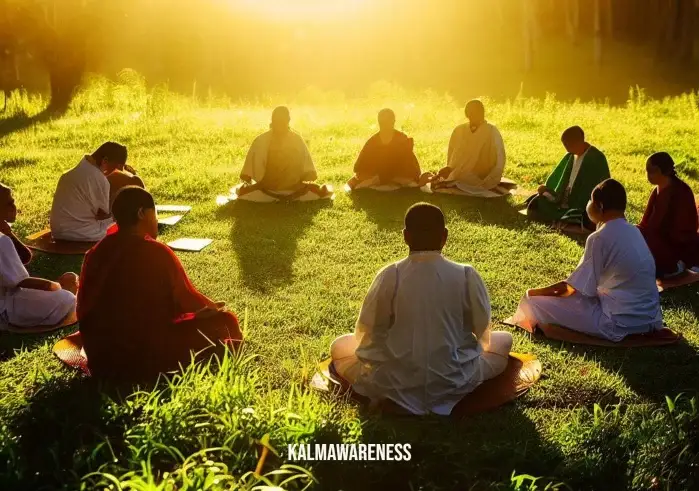Meditating on Words of Power: Harness the Profound Energy Within
A potent spiritual practice awaits those who are willing to dive deep into their inner cosmos, one that goes beyond the realms of mere mindfulness, visualization, and concentration. This is the practice of meditating on words of power – an age-old technique rooted in ancient mantras and chants that have the potential to reshape our existence.
Meditating on words of power offers a doorway to the spiritual, a path to tranquility, healing, and empowerment. Yet it’s often misunderstood or overlooked. In the next parts of this article, we’ll explore the essence of this powerful practice, its significance, and how you can incorporate it into your daily routine.
The Power of Words: More than Just Sounds
Every word carries energy, a vibrational frequency that has the potential to impact our lives profoundly. Words can heal, words can harm, words can create, and words can destroy. When we meditate on certain words or phrases, we imbue our consciousness with their inherent energy and meaning.
Through meditation with words, we can transform our thoughts, emotions, and actions. We connect deeply with our inner self and begin to radiate the energy of these words out into the world. This practice is not just about repetition; it’s about embedding these powerful words into the very fabric of our being.
The Role of Mantras
Mantras, derived from the ancient Sanskrit language, are essentially words of power. These sacred utterances, carefully chosen for their spiritual significance, play a crucial role in meditative practices. They are not mere words, but powerful tools for change and transformation.
Whether you choose an Amitabha mantra, an Amma mantra, or mantras for special situations such as anger or grief, you’re tapping into an ancient reservoir of energy. By repeatedly reciting these words of power, you’re not just chanting, but actively rewiring your brain and recalibrating your energetic vibrations.
Combining Chanting and Meditation
There’s an indissoluble bond between chanting and meditation. Chanting is not just the act of repeating certain words or phrases; it is a form of meditation in itself. Whether you’re practicing a chant for healing or focusing on aligning your chakras, you’re engaging in a deep meditative process.
Chanting helps quiet the mind, increase concentration, and foster mindfulness. It draws you into the present moment and creates a sense of peace and tranquility, allowing you to tap into a profound level of meditation. This mindfulness of sounds lays the groundwork for a more in-depth exploration of self and the universe around us.
This exploration is just the beginning of our journey into meditating on words of power. In the next part of this article, we’ll delve deeper into the methods and benefits of this practice. We’ll understand how words can affect our thoughts, our emotions, and even our physiological processes. And we’ll also explore how you can incorporate meditating on words of power into your daily life, whether it’s a quick 5-minute meditation for focus or a more immersive 2-hour session.
There’s a vast sea of wisdom to explore in the world of words of power. And it’s waiting for you to dive in.
Note: The power of words transcends the physical realm, tapping into the spiritual and mystical. When wielded mindfully, they can be the key to unlock your innate potential. Meditating on words of power is not just an act of repetition but a journey of self-discovery and transformation.
Join us in the next part of this article as we delve deeper into the practical techniques, the science behind the power of words, and much more.

The Transformational Journey: Meditating on Words of Power
In the previous part of our article, we introduced the practice of meditating on words of power, delving into the significance of mantras and the symbiotic relationship between chanting and meditation. As we proceed, we’ll explore the scientific underpinnings of this practice, understanding its impact on our brain and our overall well-being. We’ll also look into specific techniques that can help you harness the true potential of this transformative practice.
The Neuroscience of Chanting and Meditation
Understanding the science behind meditating on words of power can lend more credibility to this age-old practice. Neuroscience has made remarkable strides in unraveling the mysteries of our brain and its response to meditation.
When we engage in practices such as eye meditation, for instance, our focus converges on a single point, leading to improved concentration. Scientifically, this is due to the increased activity in the prefrontal cortex – the part of the brain associated with executive functions like attention.
Moreover, chanting mantras, such as those aimed at relieving brain fog, can lead to the activation of specific areas of the brain. This activity, in turn, helps improve our cognitive abilities, leading to enhanced clarity, focus, and memory.
Benefits of Meditating on Words of Power
The practice of meditating on words of power can lead to numerous benefits:
- Improved Focus: By concentrating on a single word or phrase, we train our brain to stay focused, enhancing our attention span. This practice can prove beneficial in activities requiring undivided attention.
- Reduced Stress: Chanting and meditation trigger the relaxation response in our body, reducing stress and promoting a sense of calm.
- Emotional Healing: Certain words or mantras can help process and heal emotional pain, fostering emotional well-being.
- Enhanced Self-Awareness: As we dive deeper into the practice, we start gaining insights into our thoughts, emotions, and behaviors, leading to increased self-awareness and personal growth.
- Increased Resilience: Regular practice of meditating on words of power can make us more resilient in the face of adversity.
Techniques to Practice Meditating on Words of Power
There are several techniques you can use to practice meditating on words of power:
- Breathwork: Coordinate your chanting with your breath. For instance, as you inhale, mentally recite the first half of the mantra, and as you exhale, recite the second half. This practice can be enhanced with certain breathing exercises.
- Visualization: Visualize the words as you chant them. See them forming in your mind’s eye and imagine their energy filling your entire being.
- Auditory Chanting: Chant the words out loud. The act of speaking and hearing the words can enhance the meditative experience.
- Writing: Write down the words or phrases repetitively. This act can help integrate the words into your subconscious mind.
| Techniques | Benefits | Related Practices |
|---|---|---|
| Breathwork | Enhances focus, reduces stress | Binaural Beats |
| Visualization | Deepens meditation, fosters creativity | Eye Meditation |
| Auditory Chanting | Stimulates auditory senses, enhances concentration | Chanting for Healing, Mindfulness of Sounds |
| Writing | Engages the subconscious mind, fosters self-awareness | Meditation Before Studying |
The journey of meditating on words of power is a personal one, tailored by your individual experiences and intentions. Remember, the path to mastering this transformative practice is one of patience, persistence, and openness.
In the next part of this article, we will delve into the world of specific mantras and how you can choose the one that resonates best with your intent. Whether you’re looking to foster love, heal emotional wounds, or enhance your focus, there’s a word of power waiting for you. So, stay tuned as we continue to unravel the mysteries of meditating on words of power.

A Symphony of Silence: The Power of Mantras
Diving deeper into our exploration of meditating on words of power, we now move towards the captivating universe of mantras. Mantras are sacred utterances, believed to possess spiritual efficiency, and when meditated upon, these words of power can work wonders. In this chapter, we’ll journey through a selection of potent mantras, exploring their meanings and the unique benefits each can bring to your spiritual practice.
Decoding Mantras: The Language of the Universe
“Man does not live by a word alone, despite the fact he sometimes has to eat them,” the renowned American writer, Adlai Stevenson, once said. This holds particularly true when we consider the profound impact of meditating on words of power.
Each mantra is distinct, carrying its vibration, intended to ignite a particular energy within us. For instance, the Amitabha mantra, originating from Buddhist teachings, is believed to invoke compassion and enlightenment. On the other hand, the Amma mantra, often recited to honor the divine mother, instills a sense of love and comfort.
Mantras for Various Intentions
It is vital to choose a mantra aligning with your intention. It becomes the focal point of your meditation, guiding your mind towards the desired state. Here are a few mantras, their meanings, and their corresponding intentions:
- Aad Guray Nameh – This Sikh mantra is used for protection, invoking the protective energy of the universe.
- Aad Such Jugaad Such – This mantra is used for truth and is believed to bring one’s true self into alignment.
- Nam Myoho Renge Kyo – This Buddhist chant is believed to unlock the potential within oneself, leading to personal transformation and enlightenment.
- Gayatri Mantra – A sacred Vedic mantra, the Gayatri Mantra is often recited for spiritual awakening and fostering wisdom.
- Ang Sung Wahe Guru – This mantra is often chanted for experiencing the divine within oneself and one’s surroundings.
Mahatma Gandhi once said, “Man becomes what he thinks about.” In the context of meditating on words of power, mantras guide our thoughts towards the intended virtues and qualities, thus fostering inner transformation.
Incorporating Mantras into Your Practice
Incorporating mantras into your meditation practice involves a few steps:
- Choose a mantra that aligns with your intention.
- Find a comfortable place where you can sit and meditate without disturbance.
- Recite the mantra either silently or out loud.
- Keep your focus on the mantra. If your mind wanders, gently bring it back to the words of power.
- Practice regularly. Consistency is key when it comes to seeing the benefits of mantra meditation.
As you delve deeper into the world of mantras, you might find yourself drawn towards chants for protection or maybe chants for healing. These are just some of the countless options available to you. Ultimately, the most important thing is to choose a mantra that resonates with you and your unique journey.
In our next chapter, we will explore the integration of visualization and concentration techniques to amplify the power of your chosen mantras. Remember, “Words have energy and power with the ability to help, to heal, to hinder, to hurt, to harm, to humiliate, and to humble,” as beautifully put by Yehuda Berg. So, let’s continue this journey of transformation as we uncover the infinite power of mantras.

Meditating on Words of Power: The Symbiosis of Visualization and Concentration
In our exploration of meditating on words of power, we’ve journeyed through the foundations of meditation, the mystical terrain of mantras, and their profound effect on the meditator. In this chapter, we’ll delve into the powerful techniques of visualization and concentration, exploring their role in amplifying the potency of mantras in your meditation practice.
Visualization: Shaping the Mind’s Eye
When you meditate on words of power, you ignite a process that combines sound, meaning, and intent. Adding visualization to this mix can significantly enhance your experience. After all, as Napoleon Hill wisely observed, “Whatever the mind can conceive and believe, it can achieve.” Visualization acts as a tool to manifest these words of power into tangible experiences.
As you meditate on the Buddha Shakyamuni mantra, for example, you can visualize the Buddha’s serene image, his compassionate gaze, and the radiant aura surrounding him. This combination of chanting and visualization creates a powerful imprint on the mind, leading to a deeper and more enriching meditation experience.
Concentration: The Anchor of Meditation
The practice of concentration is the heart of meditation. It serves as the anchor that keeps the mind from drifting into the sea of distractions. As Thomas Carlyle said, “The weakest living creature, by concentrating his powers on a single object, can accomplish something. The strongest, by dispensing his over many, may fail to accomplish anything.” When you’re meditating on words of power, concentration helps you to fully imbibe the essence of the mantra.
Consider, for instance, meditating with the Bija mantra Lam. Your mind may wander to various thoughts or external noises. But the practice of concentration helps you redirect your focus back to the mantra, ensuring that you remain engaged in the meditative practice.
Integrating Visualization and Concentration
Meditating on words of power while simultaneously applying visualization and concentration techniques can have profound effects on your overall spiritual practice. To elucidate, consider the table below:
| Technique | Mantra | How to Apply |
|---|---|---|
| Visualization | Nam Myoho Renge Kyo | Visualize a lotus blooming in your heart with each recitation. |
| Concentration | Ang Sung Wahe Guru | Focus solely on the mantra, ensuring each word is enunciated with clarity and understanding. |
| Combination | Chattr Chakkr Vartee | As you recite the mantra, visualize a protective energy surrounding you and concentrate on this protective shield with each chant. |
These techniques, when combined with meditating on words of power, can foster a deeper sense of self-awareness and spiritual connection. Remember, “Believe you can and you’re halfway there,” as Theodore Roosevelt once said. So, have faith in your practice and in the transformative power of these sacred words.
In our next chapter, we’ll explore the immense benefits of meditating on words of power and how they contribute to enhancing mental, emotional, and spiritual wellbeing. So, stay tuned and continue on this exciting journey with us.

Meditating on Words of Power: The Impact on Emotional and Spiritual Wellbeing
As we continue our exploration into meditating on words of power, we now turn to its profound influence on our emotional and spiritual wellbeing. This transformative practice can act as a salve for the mind, fostering resilience, fostering inner peace, and promoting spiritual growth.
Emotional Wellbeing: A Symphony of Calm
Meditation, especially when integrated with chanting mantras, has the power to alter emotional landscapes. By meditating on words of power like the Buddhist healing mantra, we can trigger positive emotional changes, foster a deep sense of calm, and imbue ourselves with a greater capacity for empathy and compassion.
Consider this quote from Dalai Lama, “Love and compassion are necessities, not luxuries. Without them, humanity cannot survive.” By meditating on words of power, we cultivate these very qualities, contributing significantly to our emotional wellbeing.
As we traverse the often tumultuous terrain of life, mantras like the Buddhist chant for grief can become an emotional buoy, keeping us afloat amidst the waves of sadness and despair. It serves as a reminder that while pain may be an inevitable part of life, we possess the inner strength to endure and rise above it.
Spiritual Wellbeing: A Pathway to Higher Consciousness
Spiritual wellbeing often hinges on a deep sense of connection to something greater than ourselves. Meditating on words of power provides a pathway to this connection, opening up channels of understanding and awareness that transcend the mundane.
When you meditate with Dalai Lama’s meditation techniques, you’re not just chanting words. You’re engaging in a profound spiritual practice that seeks to illuminate the mind and awaken the soul to a higher consciousness.
The mantra, Nam Myoho Renge Kyo, emphasizes this connection by encouraging us to attune ourselves with the mystic law of cause and effect through sound. It’s an invitation to fully inhabit the present moment, to embrace life with all its vicissitudes, and to recognize our inherent potential to create positive change.
The Sustained Impact of Meditating on Words of Power
To encapsulate the sustained impact of meditating on words of power, consider this list:
- Enhanced Emotional Resilience: Practices like the Ang Sung Wahe Guru chant can help develop emotional resilience, allowing you to navigate life’s ups and downs with equanimity.
- Deepened Compassion: Mantras like the Amma mantra encourage the development of deep compassion towards oneself and others, fostering a sense of interconnectedness.
- Cultivation of Inner Peace: Meditating on words of power brings clarity and calm to the mind, creating a sanctuary of inner peace even amidst external chaos.
- Spiritual Awakening: Practices like the Amitabha mantra can facilitate spiritual awakening, helping you recognize the transcendent dimensions of existence.
- Personal Transformation: By regularly meditating on words of power, you can bring about significant changes in your perceptions, attitudes, and actions, leading to personal transformation.
Meditating on words of power is a journey into the heart of self-discovery, a deep dive into the inner landscapes of consciousness, and a quest for meaningful connections with the universe. As Rumi, the mystic poet, once said, “The universe is not outside of you. Look inside yourself; everything that you want, you already are.”
In the following chapter, we will delve into practical guides for meditating on words of power, including tips for beginners and ways to incorporate this practice into daily life. Keep journeying with us as we continue to explore this fascinating subject.

A Lighter Path: Applying Words of Power in Everyday Life
After our exploration into the profound emotional and spiritual benefits of meditating on words of power, it is time to tread on a lighter path. This final chapter focuses on practical, daily applications of these powerful words. How can we integrate this ancient practice into our modern lives? How can we let these mantras illuminate our everyday paths? It’s a journey that’s as exciting as it is transformative.
Applying Words of Power in the Morning
Imagine starting your day with a purposeful pause, immersing yourself in the potent energy of Om Mani Padme Hum, a powerful mantra that invokes compassion and peace. By incorporating meditation into our morning routine, we set a positive tone for the day, a day that is guided by compassion, tranquillity, and understanding.
Everyday tasks like brushing your teeth or making your bed become moments of mindfulness, where the hum of the mantra in your mind transforms mundane moments into meditative experiences.
Harnessing Power Words During the Day
It’s inevitable. Stress, uncertainty, and frustration often punctuate our day. It is in these moments, when calm seems elusive, that meditating on words of power can make a remarkable difference.
The mantra Om Shanti Shanti Shanti, for instance, seeks to infuse peace into the mind, the world, and the entire universe. By chanting this mantra during moments of anxiety or stress, we summon inner peace, reminding ourselves of our innate ability to navigate turbulent times with grace and poise.
Reflective Evenings with Words of Power
As the day draws to a close, meditating on words of power like Lokah Samastah Sukhino Bhavantu provides a gentle, reflective space for gratitude. This mantra, which essentially wishes happiness and freedom for all beings, helps cultivate a deeper sense of interconnectedness with all of life.
Such a practice not only aids in introspection but also fosters a profound appreciation for the multitude of experiences that make up our lives. It’s a poignant reminder that our journey, with all its trials and triumphs, is deeply intertwined with the journey of others.
In essence, meditating on words of power isn’t a practice confined to the meditation cushion; it’s a vibrant tapestry that can be woven into the fabric of our everyday lives.
In the words of spiritual teacher Eckhart Tolle, “Realize deeply that the present moment is all you ever have. Make the Now the primary focus of your life.” Meditating on words of power brings us into the Now, making every moment a beautiful encounter with mindfulness.
We hope that this journey through the powerful world of mantras and meditation has been enlightening and inspiring. May these words of power illuminate your path and may they guide you towards peace, compassion, and a deeper understanding of yourself and the world.
Thank you for walking with us on this path of discovery. We invite you to continue your journey with us in our upcoming series. Explore other captivating topics and immerse yourself in the transformative power of self-awareness and mindfulness in our Kalm Awareness magazine. Let’s continue this journey together.





